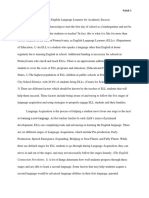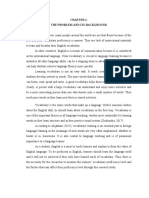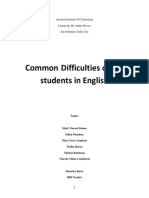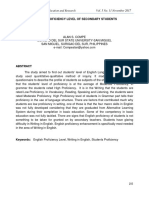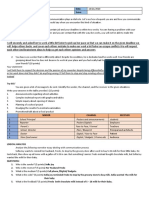Giansante Nyseslat
Giansante Nyseslat
Uploaded by
api-266338559Copyright:
Available Formats
Giansante Nyseslat
Giansante Nyseslat
Uploaded by
api-266338559Original Title
Copyright
Available Formats
Share this document
Did you find this document useful?
Is this content inappropriate?
Copyright:
Available Formats
Giansante Nyseslat
Giansante Nyseslat
Uploaded by
api-266338559Copyright:
Available Formats
Cristina Giansante
ESC 761
NYSESLAT Assessment
1. Standardized Assessment:
The NYSESLAT is a yearly exam that is given to all students who receive ESL
services to determine how well they are learning the English language. If students
pass the NYSESLAT they do not receive ESL services the following year. There are
many biases that ELLs face when taking standardized assessments such as content,
linguistic, and disproportionate representations. Laing & Camhi (2003) discuss the
large issue that many of these tests are created under the assumption that all
children have been exposed to the same concepts and vocabulary, or have similar
experiences to that of their age. Unfortunately, this is not the case due to the wide
range of life experiences students have faced in their past. Norm-Referenced and
Criterion-Referenced assessments are extremely unreliable indicators of ELLs
content knowledge and skills, but are often used to measure both.
Norm-Referenced tests, such as the SAT, only recognize one type of English
language and do not recognize dialects. Students who are new to the English
language or have grown up being taught a dialect of English often are
misrepresented by these exams because of the language structure. Solano-Flore &
Trumbell (2003), found that different socio-economic status interpret words
differently. Culturally diverse students have a difficult time interpreting words in
problems correctly due to the vary in context it is used. In the past culturally and
linguistically diverse students have not been included in the norm samples, which
results in an unfair disadvantage to these students. Criterion-Referenced
assessments compare all students skills to pre-determined criteria. Regardless of
the students cultural or linguistic background they are assumed to score in
comparison to the pre-determined criteria. Exams like the Regents and other state
tests often lack data on culturally and linguistically diverse populations, so these
students often perform and score poorly.
Despite the bias faced, standardized assessment data can be used to plan
instruction and improve programs by noting trends in responses, such as language
structure; if many students are getting language and vocabulary questions wrong,
this could be implemented into the curriculum for the following year. These
assessment creators can also note large incorrect responses and correlate them
with the students; if they notice a correlation between CLD and incorrect responses,
these questions could be eliminated or tailored for the following year due to bias.
Laing, S., & Kamhi, A. (2003). Alternative Assessment Of Language And Literacy In
Culturally And Linguistically Diverse Populations. Language, Speech, and
Hearing Services in Schools, 44-55.
Solano-Flores, G., & Trumbull, E. (2003). Examining Language In Context: The Need
For New Research And Practice Paradigms In The Testing Of English-Language
Learners. Educational Researcher, 3-13.
2. Authentic Assessments:
Colorin Colorado discuses the benefits of using authentic assessments to
target student problem areas, show growth through the school year, and to help
adapt instruction through out the school year. These authentic assessments can
demonstrate more of an accurate portrayal of an ELLs content and linguistic skills
than that of standardized tests. These assessments allow students the opportunity
to demonstrate their knowledge and provide educators with a more in-depth look at
their academic needs. Performance-based assessments and portfolio assessments
are two of the most commonly used authentic methods, although they measure
progress accurate progress toward objectives, educators face challenges in
assessing ELLs language proficiency and content knowledge.
The biggest challenge educators face is getting ELLs to learn grade level
content even though they are still learning the English language. As educators we
have to capitalize on ELLs thinking ability and encourage critical thinking skills to
compensate for the language development, but how do we do so when all our ELLs
are learning at different proficiency levels? A challenge educators could face in the
classroom is differentiation of these authentic assessments due to the vast
proficiency levels of ELLs. Finding a task that can assess the entire class, but yet
demonstrating each students appropriate proficiency level could be quite the
challenge. Teachers should be aware of using any assessments that use thick
language to assess a student due to its poor validity on the students content
knowledge.
Using Informal Assessments for English Language Learners | Colorn
Colorado. (2007, January 1). Retrieved September 12, 2014, from
http://www.colorincolorado.org/educators/assessment/informal/
3.
In order for students to be successful on the NYSESLAT they must meet the
standards in speaking, listening, reading, and writing. Throughout these sections
they are responsible for completing sentence ideas, responding to picture prompts,
making inferences, showing comprehension of text, and the ability to write with
appropriate sentence structure and grammar.
I believe that as the exam continues the questions and demands increasingly
get harder and slightly thicker in language. I believe an issue with this exam could
be that students may be very successful on one part of the exam, and do poorly on
the rest because their language is not as proficient in that other section, such as
listening, or reading, or writing. It leaves room for a lot of misinterpretation of how
the student is growing as a learner.
After reviewing the exam and sample questions one could get a feel for what
topics are addressed on the NYSESLAT exam, which could be beneficial when
creating lessons. As an educator you can find ways to implement a lesson to feature
a task such as, speaking, or listening, to help ease the students into this process. I
dont believe teaching to the test is the proper way of instructing, but in this case to
not have the students feel so overwhelmed it could be helpful to their anxiety if they
are taught strategies on how to attack comprehension or inference questions, and so
on. The problem that is still posed is what if your student does not have the
language proficiency to complete these tasks, but does know the content knowledge
in their native language, its just translating it. That is where the NYSESLAT becomes
an inaccurate assessment.
4.
The 8
th
grade ELA exam is a common core assessment that is administered to
all students in the 8
th
grade, unlike the NYSESLAT, which is administered to just ESL
students. Both exams are similar in that the students are being asked to make
inferences, write full and complete sentences, respond to picture prompts, and
comprehend text. Students on both exams are being asked to analyze texts and
respond through multiple choice, short response, and extended response.
The ELA exam focuses a lot on vocabulary knowledge as well, almost every
question requires students to determine and/or clarify the meaning of words given.
A lot of sophisticated content specific vocabulary is used throughout the ELA exam;
students would have to have a firm understanding of the English language in order
to fully understand these questions and passages. For example in passage one, the
question asks what momentous means (pg. 3). The answers the students can
choose from also include intermediate 8
th
grade vocabulary such as disturbance,
and historically. This use of vocabulary will make it essentially impossible for an
ELL to get this answer correctly.
This exam also requires students to use text evidence to support their
answers. The questions found on the ELA exam have the students focusing on verbal
details, whereas the students on the NYSESLAT are focused more on responding to
visual detail. Common Core wants to see that all students are able to reach the
grade-mandated standards; regardless of students language proficiency they are all
scored with the same expectations.
5.
The 8
th
grade math exam states that it is designed to assess students on their
understanding of mathematics. Through out the exam they are asked to complete
multiple step problems that demonstrate an understanding of the application of
mathematics skills, and real-world applications. However, it does not mention it is
measuring a students content specific vocabulary first. Immediately after looking at
this exam it is clear that a student must have a firm understanding of sophisticated
vocabulary, and of the English language. Question 2 (pg. 2) is assessing the students
on how well they can determine if an equilateral triangle could be congruent to that
of a triangle, even if transformations were used. The question is extremely wordy,
and even something I myself had to read out loud a few times to understand the
process in which the question was asking me to go through. The amount of content
vocabulary used in the question alone is enough to send an ELLs anxiety through
the roof. Words such as equilateral, transformation, rotations, reflections,
translations, scalene, and obtuse are words that even English speaking students
may have a hard time with. The questions presented on this exam are wordy and
thick in language.
When comparing the 8
th
grade NYSESLAT exam to the 8
th
grade math exam,
the language demands and expectations are on two extremely different ends. If
presented with the two exams and having no background knowledge I would never
believe that the same student was being asked to take both. The language demands
of the NYSESLAT are basic English functions that demonstrate a students
understanding and application of the language. The 8
th
grade math exam is designed
for the English speaker who has a firm understanding of vocabulary, specific content
vocabulary, and math concepts. When comparing the two exams I believe the
NYSESLAT exam is a better assessor (of the two) for how the ELLs understand
language to an extent, however, it is by no means an adequate assessment of an
ELLs ability to do well in mainstream content classes at the secondary level. The
language demands of the mainstream classroom are far too sophisticated for ELLs at
this point; they will never be able to learn concepts in a mainstream classroom if
they are still learning the basic functions of the English language.
You might also like
- Kaufman Test of Education Achievement Second EditionDocument6 pagesKaufman Test of Education Achievement Second Editionapi-311622387No ratings yet
- 4a ReflectionDocument2 pages4a Reflectionapi-356579305No ratings yet
- Savage Grammar Matters PDFDocument45 pagesSavage Grammar Matters PDFnamavayaNo ratings yet
- Chapters 1 5 Complete Ver 4Document73 pagesChapters 1 5 Complete Ver 4Shinki MirikaNo ratings yet
- Subject Assignment: Approaches To Language in The Classroom ContextDocument10 pagesSubject Assignment: Approaches To Language in The Classroom ContextMaye MaldonadoNo ratings yet
- Erwin - Rebecca FRIT 7231 KADocument26 pagesErwin - Rebecca FRIT 7231 KAbecca3757No ratings yet
- Assessment - Week #1 Reflection - ReidyDocument4 pagesAssessment - Week #1 Reflection - ReidyGinaNo ratings yet
- ErinbaskindebatepaperDocument6 pagesErinbaskindebatepaperapi-398411756No ratings yet
- ArenstamactionresearchpDocument22 pagesArenstamactionresearchpapi-277203496No ratings yet
- Esl Leraners Problems in Using TensesDocument7 pagesEsl Leraners Problems in Using TensesTanussa BenitaNo ratings yet
- An Analysis On Students' Grammatical Error of Degree of Comparison SentencesDocument49 pagesAn Analysis On Students' Grammatical Error of Degree of Comparison SentencesValbona BytyçiNo ratings yet
- Assessment PlanDocument8 pagesAssessment Planapi-322101445No ratings yet
- Order-342051443 Standardized TestingDocument6 pagesOrder-342051443 Standardized TestingRemmy MuruleNo ratings yet
- Final Research Paper GuideDocument21 pagesFinal Research Paper GuidemecomaranoNo ratings yet
- K 1Document15 pagesK 1ayuniNo ratings yet
- Traditional Tests: Assessing LearningDocument2 pagesTraditional Tests: Assessing LearningMihaela AdrianaNo ratings yet
- Artifact For Standard 4Document3 pagesArtifact For Standard 4api-336392677No ratings yet
- Equity, Reliability, and Validity of SATs in ESL 1Document7 pagesEquity, Reliability, and Validity of SATs in ESL 1Gladys vidzoNo ratings yet
- Ell Handbook Mathematic PDFDocument22 pagesEll Handbook Mathematic PDFameera mohammed abdullahNo ratings yet
- Chapter 1-3Document37 pagesChapter 1-3VELASCO, NAPOLEON III P.No ratings yet
- Elizabeth Jiménez, CEO GEMAS Consulting and AdvocacyDocument11 pagesElizabeth Jiménez, CEO GEMAS Consulting and AdvocacyseaburgaNo ratings yet
- Understanding EFL Learners' Errors in Language Knowledge in Ongoing AssessmentDocument8 pagesUnderstanding EFL Learners' Errors in Language Knowledge in Ongoing AssessmentvaldezjwNo ratings yet
- 4 Reflect SmarterbalanceDocument4 pages4 Reflect Smarterbalanceapi-315537808No ratings yet
- Assignment InterlanguagesDocument10 pagesAssignment InterlanguagesMatias AratanoNo ratings yet
- A Summary LANGUAGE ASSESSMENT: Principle and Classroom Practice H. Douglas Brown (2003)Document5 pagesA Summary LANGUAGE ASSESSMENT: Principle and Classroom Practice H. Douglas Brown (2003)fildzahNo ratings yet
- C Scott - El ArpDocument10 pagesC Scott - El Arpapi-263802017No ratings yet
- Research Latest 1Document25 pagesResearch Latest 1Janife PerezNo ratings yet
- EllcultureprojectDocument9 pagesEllcultureprojectapi-457013656No ratings yet
- Chapter 1-5 Vocabulary Teaching PracticesDocument56 pagesChapter 1-5 Vocabulary Teaching PracticesRex CelNo ratings yet
- Chapter 1Document9 pagesChapter 1VELASCO, NAPOLEON III P.No ratings yet
- The Design of Discrete Vocabulary TestsDocument5 pagesThe Design of Discrete Vocabulary TestsZeta Andrea ArdanNo ratings yet
- Assessment Framework and TimelineDocument4 pagesAssessment Framework and Timelineapi-251657289No ratings yet
- Assessing Understanding: Receptive and Productive SkillsDocument3 pagesAssessing Understanding: Receptive and Productive SkillsSajjad AliNo ratings yet
- Pencil and Paper TestsDocument3 pagesPencil and Paper TestsPopescu Madalina LilianaNo ratings yet
- Diversity Research PaperDocument7 pagesDiversity Research Paperapi-350135782No ratings yet
- Grammatical Competence of First Year EngDocument54 pagesGrammatical Competence of First Year EngCharlyne Mari FloresNo ratings yet
- New York State Testing Program Grade 7 Common Core English Language Arts TestDocument44 pagesNew York State Testing Program Grade 7 Common Core English Language Arts TestramjdNo ratings yet
- Chapter 1 3Document119 pagesChapter 1 3John Stephen CastilloNo ratings yet
- FP001-Assignment - Ada Socolich-2023Document13 pagesFP001-Assignment - Ada Socolich-2023Ian LealandNo ratings yet
- Understanding English Language Learners August 2012Document42 pagesUnderstanding English Language Learners August 2012api-222269731No ratings yet
- RRL ChaDocument7 pagesRRL ChaChariz SandaloNo ratings yet
- Concept Paper in ALM221Document10 pagesConcept Paper in ALM221Giselle Sadural CariñoNo ratings yet
- Advanced Institu 2Document10 pagesAdvanced Institu 2Mariel Dizon BermeNo ratings yet
- English Proficiency Level of Secondary StudentsDocument10 pagesEnglish Proficiency Level of Secondary StudentsShiera Mae Labial LangeNo ratings yet
- ProposalDocument4 pagesProposaldaysee garzonNo ratings yet
- 2019 Released Items Ela g3Document38 pages2019 Released Items Ela g3mohammed el erianNo ratings yet
- Isl Conference Esol StrategiesDocument54 pagesIsl Conference Esol Strategiesapi-250481789No ratings yet
- English 203: Advanced Methods in Language and Literature AssessmentDocument3 pagesEnglish 203: Advanced Methods in Language and Literature AssessmentGray VillaruelNo ratings yet
- The Six Stages of Second Lang LinguisticsDocument6 pagesThe Six Stages of Second Lang LinguisticsYusef KhNo ratings yet
- Grammatical Competence of First Year EngDocument54 pagesGrammatical Competence of First Year Engciedelle arandaNo ratings yet
- Research ProposalDocument5 pagesResearch Proposalraynold raphaelNo ratings yet
- The Effects of Using Crossword PuzzleDocument13 pagesThe Effects of Using Crossword PuzzleJeff Jj100% (3)
- VCE English Language 2016-2021: School-Assessed Coursework ReportDocument5 pagesVCE English Language 2016-2021: School-Assessed Coursework Reportdinho91No ratings yet
- Rti k-12 ElsDocument7 pagesRti k-12 Elsapi-238441684No ratings yet
- Linguistic ThesisDocument12 pagesLinguistic ThesisMarylyn CapingolNo ratings yet
- Error Analysis Article Stage of Errors-2Document13 pagesError Analysis Article Stage of Errors-2Elissa SwtNo ratings yet
- Regents Exams and Answers: English Revised EditionFrom EverandRegents Exams and Answers: English Revised EditionNo ratings yet
- Understanding and Interpreting Data on the Learning of English Tenses and Verb Forms: A Research-Based Resource Book for the Teaching of English as a Second LanguageFrom EverandUnderstanding and Interpreting Data on the Learning of English Tenses and Verb Forms: A Research-Based Resource Book for the Teaching of English as a Second LanguageNo ratings yet
- Reflection 5bDocument2 pagesReflection 5bapi-266338559No ratings yet
- Reflection 4cDocument2 pagesReflection 4capi-266338559No ratings yet
- Reflection 1 Standard 3cDocument2 pagesReflection 1 Standard 3capi-266338559No ratings yet
- StcsDocument2 pagesStcsapi-266338559No ratings yet
- Ede 727 Ss LessonDocument7 pagesEde 727 Ss Lessonapi-266338559No ratings yet
- Reflection 1 3 BDocument2 pagesReflection 1 3 Bapi-266338559No ratings yet
- Giansante - Ede727 Ela Lesson1 FinalDocument10 pagesGiansante - Ede727 Ela Lesson1 Finalapi-266338559No ratings yet
- Giansante - Philosophy StatementDocument6 pagesGiansante - Philosophy Statementapi-266338559No ratings yet
- Reflection 1b - SlaDocument2 pagesReflection 1b - Slaapi-266338559No ratings yet
- Reflection 1 Standard 3 ADocument2 pagesReflection 1 Standard 3 Aapi-266338559No ratings yet
- Customer Journey of AmazonDocument8 pagesCustomer Journey of AmazonNithish LNo ratings yet
- Basic Competencies TMDocument3 pagesBasic Competencies TMGracia GagahNo ratings yet
- Write en Fight The FogDocument19 pagesWrite en Fight The FogDan DannyNo ratings yet
- Communicative Language Teaching ApproachDocument5 pagesCommunicative Language Teaching ApproachBerfinNo ratings yet
- Presentation 4Document10 pagesPresentation 4Barazeduka AnselmoNo ratings yet
- Lesson Plan Format 11 16 2015 1Document2 pagesLesson Plan Format 11 16 2015 1api-336537681No ratings yet
- 15 Part IV-Designing The Global Marketing Program - Product and Service Decisions - Lecture No. 7-1Document30 pages15 Part IV-Designing The Global Marketing Program - Product and Service Decisions - Lecture No. 7-1Sabin ShresthaNo ratings yet
- FamilyDocument4 pagesFamilyMasniahNo ratings yet
- Job Genius Video Series Soft Skills Worksheet and Answer GuideDocument2 pagesJob Genius Video Series Soft Skills Worksheet and Answer GuideYader Pineda PradoNo ratings yet
- WateenDocument35 pagesWateenNoor E SaherNo ratings yet
- Eta Fajrani AdamDocument3 pagesEta Fajrani AdamAlvian Pratama OmbiNo ratings yet
- Affidavit of Translation - SampleDocument2 pagesAffidavit of Translation - SampleWilson ManalangNo ratings yet
- Saad PHD PDFDocument173 pagesSaad PHD PDFMotaz K. SaadNo ratings yet
- 8 Questions To Ask An InterviewerDocument3 pages8 Questions To Ask An InterviewerJa Phe TiNo ratings yet
- Bring Your Brain To Work - Book Summary - Accel5Document6 pagesBring Your Brain To Work - Book Summary - Accel5maria pia otarolaNo ratings yet
- Using Reading Skills - How Writers Achieve EffectsDocument2 pagesUsing Reading Skills - How Writers Achieve Effectssteph67% (3)
- صواتة عروضية أم صواتة مستقلة القطعDocument15 pagesصواتة عروضية أم صواتة مستقلة القطعMbarek Hanoun50% (2)
- (Template) Activity Number 1Document1 page(Template) Activity Number 1arniel abapoNo ratings yet
- Writing Skills Assignment #3: Confederation College's LibraryDocument2 pagesWriting Skills Assignment #3: Confederation College's LibraryKunal BasraNo ratings yet
- Craig, A. Theorizing CommunicationDocument10 pagesCraig, A. Theorizing CommunicationMónica Yañez40% (10)
- School: Grade LevelDocument6 pagesSchool: Grade LevelRomelSorianoLadislaoNo ratings yet
- RPL 4 - Learner - S Checklist of Competencies (AE)Document2 pagesRPL 4 - Learner - S Checklist of Competencies (AE)Kimberly Humawan100% (1)
- Engineering Resume For InternshipDocument1 pageEngineering Resume For InternshipWelhelmshaven Monzolin PantorillaNo ratings yet
- 5 Syntactic StructuresDocument16 pages5 Syntactic StructuresVldz MrlyNo ratings yet
- Unidad 2 Actividad 1Document4 pagesUnidad 2 Actividad 1Orly Alexander Fernandez ParragaNo ratings yet
- Purposive CommunicationDocument4 pagesPurposive Communicationjames van naronNo ratings yet
- Self and Peer AssessmentDocument26 pagesSelf and Peer AssessmentNishima SagarNo ratings yet
- En FR 8.5.1 Dep BookDocument286 pagesEn FR 8.5.1 Dep BookBoris FontecillaNo ratings yet
- DEEPIKA Cs 419Document10 pagesDEEPIKA Cs 419Krishna ReddyNo ratings yet
- DLL - English 2 - Q1 - W2Document3 pagesDLL - English 2 - Q1 - W2Chris Loidz Ganado100% (1)



























